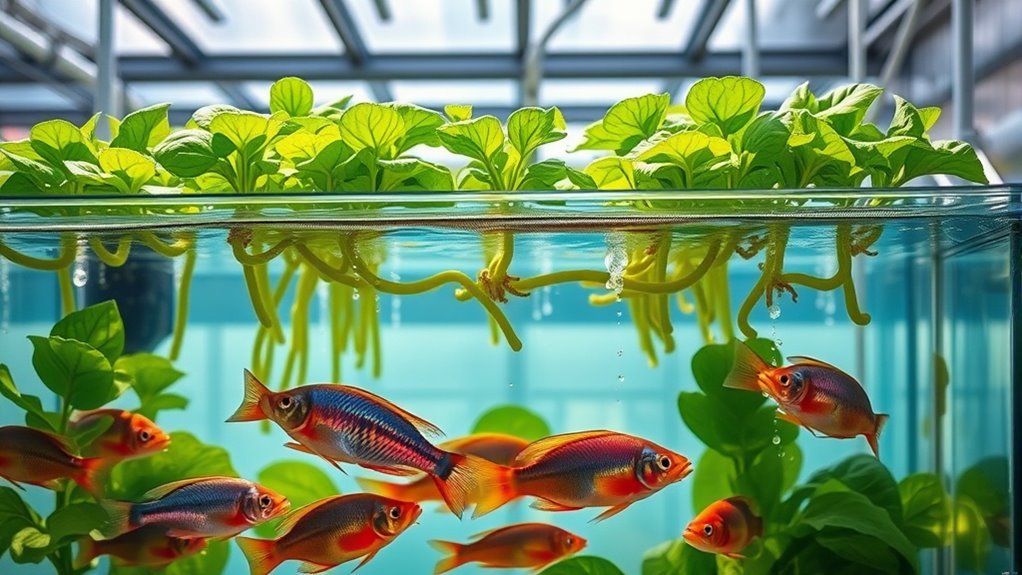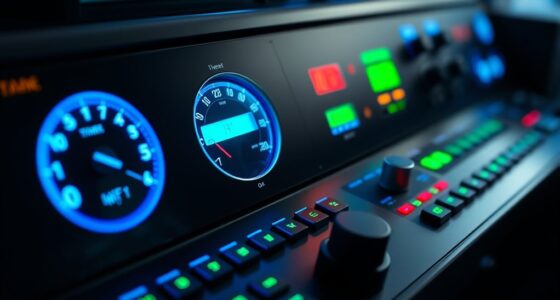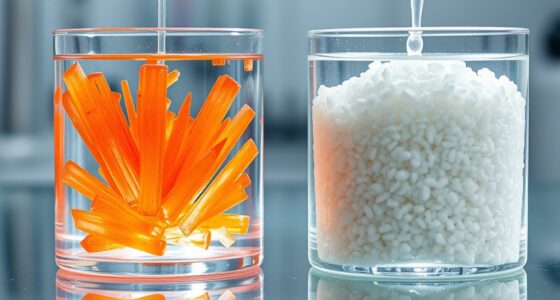In aquaponics, you create a balanced ecosystem by combining fish and plants, where water cleanliness is essential. You’ll manage water cycling carefully, using pumps and timers to maintain steady flow while monitoring pH, ammonia, and nitrates to keep conditions ideal. Proper fish stocking prevents waste overloads, ensuring your system runs smoothly. Using the right equipment and techniques enhances fish health and plant growth. Keep going for expert tips on building and maintaining a thriving aquaponics setup.
Key Takeaways
- Understand the basics of water cycling to effectively integrate fish tanks with plant grow beds.
- Maintain proper water quality parameters (pH, ammonia, nitrates) for healthy fish and optimal plant growth.
- Manage fish stocking levels to prevent overloading, ensuring efficient waste filtration and system balance.
- Use appropriate equipment like biofilters and aeration systems to support healthy aquatic environments.
- Regularly monitor and adjust water flow, temperature, and nutrient levels for a sustainable aquaponics system.

Ever wondered how you can grow fresh vegetables and raise fish simultaneously with minimal effort? That’s the beauty of aquaponics—a system that combines aquaculture with hydroponics, creating a symbiotic environment where plants and fish thrive together. To get started, it’s essential to understand the importance of maintaining fish health, which hinges on proper water cycling. When water circulates effectively through your system, it guarantees that the fish are in a clean, oxygen-rich environment, reducing stress and preventing disease. Water cycling involves moving water from the fish tanks to the grow beds and back again, providing nutrients to your plants while filtering out waste. This process must be carefully managed; too little flow can lead to stagnant water and compromised fish health, while excessive flow might stress your aquatic friends.
A well-designed water cycle guarantees that fish waste, rich in nutrients, gets converted by beneficial bacteria into plant-usable forms. This biological filtration is key to a successful aquaponics setup. You should aim for a steady, moderate flow that maintains oxygen levels and prevents debris buildup. Using a reliable pump and timer, you can automate this process, ensuring consistent water movement without constant manual intervention. Regularly monitoring water parameters—pH, ammonia, nitrites, and nitrates—is essential. Keeping these within ideal ranges helps maintain fish health and promotes vigorous plant growth. When water quality fluctuates, it can weaken fish immune systems and lead to disease outbreaks, so consistent testing and adjustments are crucial.
Additionally, maintaining proper fish density and stock levels is necessary to prevent overloading the system. Too many fish produce excess waste, which can overwhelm your filtration capacity and cause ammonia spikes. Proper water cycling helps mitigate this by continuously removing toxins and replenishing oxygen levels, but it’s also important to stock your system thoughtfully based on its size. Ensuring your fish are healthy involves providing the right temperature, clean water, and a balanced diet. Healthy fish produce cleaner waste, making the water cycling process more efficient and reducing the risk of illness.
Furthermore, integrating aquaponics-specific equipment such as biofilters and aeration systems can greatly improve overall system efficiency and fish health.
In essence, successful aquaponics relies on a delicate balance of water cycling, fish health, and plant nutrition. When water flows smoothly and your fish are thriving, your plants will flourish as well. Keep a close eye on water quality, regulate flow rates, and avoid overcrowding, and you’ll create a sustainable system that provides fresh vegetables and healthy fish with minimal fuss. With a little attention to these details, aquaponics becomes an enjoyable and rewarding way to grow food naturally.
Frequently Asked Questions
What Are the Best Fish Species for Beginner Aquaponics Systems?
When choosing fish for your beginner aquaponics system, you should consider fish compatibility and aquatic plant choices. Hardy species like tilapia, goldfish, or koi are great because they tolerate varying conditions and are easy to care for. These fish work well with a variety of aquatic plants, ensuring a balanced ecosystem. By selecting these resilient fish, you’ll create a sustainable, low-maintenance environment perfect for starting your aquaponics journey.
How Do I Balance Nutrient Levels Between Fish and Plants?
To balance nutrient levels, you need to monitor water testing regularly, adjusting as needed, and manage nutrient supplementation carefully. Keep an eye on ammonia, nitrite, nitrate, and pH levels to guarantee ideal conditions for both fish and plants. Feed your fish appropriately, remove excess waste, and add supplements only when necessary. Consistent testing and mindful adjustments create harmony, supporting healthy plant growth and thriving fish populations simultaneously.
What Are Common Disease Issues in Aquaponics Setups?
You’ll face common disease issues like bacterial infections, fungal problems, and pests that threaten your aquaponics setup. To manage these, focus on pest management strategies and maintaining ideal water quality, which helps prevent disease spread. Regularly monitor fish and plant health, clean systems thoroughly, and use organic treatments when needed. Keeping your environment balanced is key to preventing disease outbreaks and ensuring a healthy, productive aquaponics system.
How Much Space Is Needed for a Small-Scale Aquaponics System?
For a small-scale aquaponics system, you’ll need about 3 to 4 square feet for every 10 gallons of water. Your space requirements depend on your system sizing and the types of fish and plants you want to grow. Make sure to leave enough room for maintenance, filtration, and fish health. Starting with a compact setup allows you to learn and expand as you gain experience.
Can Aquaponics Systems Be Integrated With Renewable Energy Sources?
They say, “Where there’s a will, there’s a way.” You can absolutely integrate aquaponics systems with renewable energy sources like solar power and wind energy. These sources can power pumps, sensors, and control systems, making your setup more sustainable. Using renewable energy reduces reliance on grid power, cuts costs, and minimizes environmental impact. With some planning, you’ll have a greener, more efficient system that thrives on clean energy.
Conclusion
Now that you see how fish and plants thrive together, you’re bridging two worlds—nature’s harmony and human innovation. Aquaponics combines the serenity of aquatic life with the vigor of lush plants, proving that balance isn’t just a concept but a practical approach. As you embrace this system, remember it’s not just about growing food; it’s about nurturing an ecosystem where technology and nature coexist, creating a sustainable future right in your own space.










